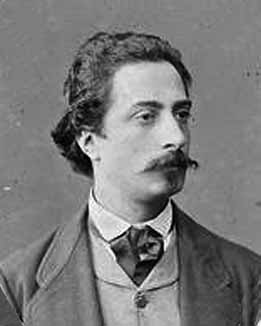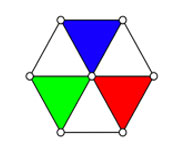


 تاريخ الرياضيات
تاريخ الرياضيات
 الرياضيات في الحضارات المختلفة
الرياضيات في الحضارات المختلفة 
 الرياضيات المتقطعة
الرياضيات المتقطعة
 الجبر
الجبر
 الهندسة
الهندسة 
 المعادلات التفاضلية و التكاملية
المعادلات التفاضلية و التكاملية 
 التحليل
التحليل
 علماء الرياضيات
علماء الرياضيات |
Read More
Date: 12-12-2016
Date: 8-12-2016
Date: 19-12-2016
|
Died: 18 February 1900 in Rome, Italy

Eugenio Beltrami's father, also called Eugenio Beltrami, was an artist who painted miniatures. His father had come from an artistic family, for his own father had engraved precious stones. The young Eugenio certainly inherited artistic talents from his family, but in his case in addition to the mathematical talents he would acquire, it was music rather than painting that became important in his life.
Beltrami studied at Pavia from 1853 to 1856, and there he was taught by Brioschi who had been appointed as professor of applied mathematics at the University of Pavia the year before Beltrami began his studies. Beltrami would have liked to continue his mathematical studies but he was suffering financial hardshipso in 1856 he had to stop his studies and take up a job. He was employed as the secretary to a railway engineer and this job took him first to Verona and then to Milan.
While Beltrami was in Milan the Kingdom of Italy was established in 1861. It was an important political event which did much to invigorate the academic scene in Italy although it seemed unlikely that Italy could achieve the economic progress made by other European countries since over three quarters of the population was illiterate and most were engaged in agriculture.
At Milan Beltrami began to work hard at his mathematical studies again and in 1862 he published his first paper. He was appointed to the University of Bologna in 1862 as a visiting professor of algebra and analytic geometry. After two years in Bologna, Beltrami accepted the chair of geodesy at the University of Pisa, which he held from 1864 to 1866. At Pisa he became friendly with Betti. In 1866 he returned to Bologna where he was appointed professor of rational mechanics.
When the Kingdom of Italy was established in 1861 Turin was the capital. In 1870 Italian troops entered Rome. The city had been held by the Pope with support from the French, but after Napoleon III was defeated and abdicated, French support to hold Rome evaporated. A new University of Rome was set up in the new Italian capital and Beltrami was appointed to the chair of rational mechanics there in 1873. After three years in Rome, Beltrami moved to Pavia to take up the chair of mathematical physics there. However, Beltrami returned to Rome in 1891 and spent his last years teaching there.
Influenced by Cremona, Lobachevsky, Gauss and Riemann, Beltrami contributed to work in differential geometry on curves and surfaces. He translated Gauss's work on conformal representation into Italian. He then considered the problem of when the geodesics on a surface could be represented as straight lineson the plane. Beltrami showed that not all geodesics could be represented in this way and he then went on to consider the natural question of which surfaces had the property that geodesics on the surface could be represented as straight lines on the plane. His answer was very pleasing, for he discovered that they were precisely the surfaces of constant curvature. Beltrami then considered surfaces of constant negative curvature and was led to his most famous results of 1868.
His 1868 paper Essay on an interpretation of non-euclidean geometry which gives a concrete realisation of the non-euclidean geometry of Lobachevsky and Bolyai and connects it with Riemann's geometry. The concrete realisation uses the pseudosphere, a surface generated by the revolution of a tractrix about its asymptote.
Beltrami in this 1868 paper did not set out to prove the consistency of non-Euclidean geometry or the independence of the Euclidean parallel postulate. What he suggested was that Bolyai and Lobachevsky had not really introduced new concepts at all but had described the theory of geodesics on surfaces of negative curvature. Beltrami wrote in this paper:-
We have tried to find a real foundation to this doctrine, instead of having to admit for it the necessity of a new order of entities and concepts.
Houel translated both Lobachevsky's and Beltrami's work into French in 1870 and he noted how Beltrami's paper proved the independence of the Euclid's parallel postulate.
The 1868 paper should have appeared sooner but it was delayed in its publication because Cremona was not entirely happy that it was not based on a circular argument. Cremona worried that euclidean geometry was being used to describe non-euclidean geometry and he saw a possible logical difficulty in this. Cremona was wrong, but his worries caused Beltrami to put his work on one side for a while but the work of Riemann convinced Beltrami that his methods were sound.
Beltrami also worked on optics, thermodynamics, elasticity, electricity and magnetism. His contributions to these topics appeared in the four-volume work, Opere Matematiche (1902-20), published posthumously. Some of his work on physical topics relates to his non-euclidean geometry for he examined how the gravitational potential as given by Newton would have to be modified in a space of negative curvature. He gave a generalised form of the Laplace operator.
In [11] Tazzioli examines how Beltrami used differential parameters when considering problems in mechanics, elasticity, and potential theory. He also used them in giving a generalisation of Green's theorem. Beltrami indirectly influenced the development of tensor analysis by providing a basis for the ideas of Ricci-Curbastro and Levi-Civita on the topic.
Some of Beltrami's last work was on a mechanical interpretation of Maxwell's equations. There are interesting insights into Beltrami's thinking on this topic contained in his correspondence with Cesàro some of which is reproduced in [7]. One of these letters [7]:-
... (dated December, 1888) is devoted to the mechanical interpretation of Maxwell's equations. Here, Beltrami showed a new proof of the conditions when six given functions are the components of an elastic deformation.
Finally we should mention an important contribution by Beltrami to the history of mathematics. This appears in a 1889 publication in which Beltrami brought to the attention of the mathematical world Saccheri's 1733 study of the parallel postulate. He compared Saccheri's results with those of Borelli, Wallis, Clavius and the non-euclidean geometry of Lobachevsky and Bolyai.
Beltrami achieved an important role in Italian mathematics, becoming President of the Accademia dei Lincei in 1898. In 1899 he became a senator of the Kingdom of Italy.
Articles:



|
|
|
|
التوتر والسرطان.. علماء يحذرون من "صلة خطيرة"
|
|
|
|
|
|
|
مرآة السيارة: مدى دقة عكسها للصورة الصحيحة
|
|
|
|
|
|
|
نحو شراكة وطنية متكاملة.. الأمين العام للعتبة الحسينية يبحث مع وكيل وزارة الخارجية آفاق التعاون المؤسسي
|
|
|